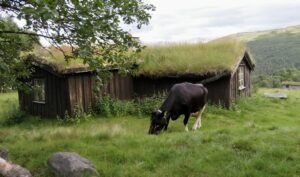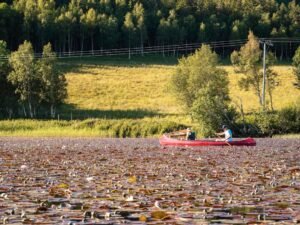

Travel Blogging in Norwegian: Vocabulary for Sharing Your Journeys
Travel blogging has become increasingly popular in recent years, and Norway is no exception. With its stunning landscapes, rich culture, and adventurous spirit, Norway offers endless opportunities for travel bloggers to share their experiences with the world. However, one important aspect of travel blogging that often gets overlooked is language skills. In order to effectively communicate with your audience and connect with locals, it is crucial to have a strong command of the language. This article will explore the importance of language skills in travel blogging and provide tips for improving your Norwegian vocabulary.
Table of Contents
ToggleKey Takeaways
- Travel blogging in Norwegian can be a great way to share your experiences with a wider audience.
- Building a strong vocabulary is essential for effectively communicating your travel experiences in Norwegian.
- Learning basic Norwegian phrases can help you connect with locals and enhance your travel experiences.
- Describing your travel experiences in Norwegian can add depth and authenticity to your blog posts.
- Knowing vocabulary related to food, dining, transportation, and accommodation can make your travel blogging more informative and engaging.
Importance of Vocabulary in Sharing Your Journeys
Having a strong vocabulary is essential for travel bloggers as it allows them to effectively describe their experiences and engage their readers. By using descriptive language, bloggers can paint a vivid picture of the places they visit, making their readers feel like they are right there with them. Additionally, a wide range of vocabulary allows bloggers to express their thoughts and emotions accurately, creating a more personal connection with their audience.
Expanding your vocabulary is an ongoing process that requires dedication and practice. One effective way to do this is by reading extensively in Norwegian. Whether it’s books, newspapers, or online articles, exposing yourself to different types of texts will introduce you to new words and phrases. Another helpful tip is to keep a vocabulary journal where you can jot down new words and review them regularly. Additionally, using flashcards or language learning apps can be a fun and interactive way to expand your vocabulary.
Basic Norwegian Phrases for Travel Blogging
When starting out as a travel blogger in Norway, it’s important to have some basic phrases under your belt. This will not only help you navigate the country more easily but also allow you to connect with locals on a deeper level. Here are some common phrases for greeting, introducing yourself, and asking for directions:
– “Hei” – Hello
– “Hva heter du?” – What is your name?
– “Jeg heter…” – My name is…
– “Takk” – Thank you
– “Unnskyld” – Excuse me
– “Hvor er…” – Where is…
– “Kan du hjelpe meg?” – Can you help me?
Pronunciation in Norwegian can be a bit tricky for non-native speakers, but with practice, it becomes easier. One important thing to note is that Norwegian has several different dialects, so pronunciation may vary depending on the region. However, here are some general tips to help you get started:
– The letter “å” is pronounced like the “o” in “dog.”
– The letter “ø” is pronounced like the “u” in “hurt.”
– The letter “j” is pronounced like the “y” in “yes.”
– The letter “g” is pronounced like the “g” in “go.”
Describing Your Travel Experiences in Norwegian
When it comes to travel blogging, being able to effectively describe your experiences is key. Here are some vocabulary words and phrases that will help you paint a vivid picture of your adventures in Norway:
– “Vakker” – Beautiful
– “Breathtaking” – Spektakulær
– “Picturesque” – Malerisk
– “Adventurous” – Eventyrlig
– “Charming” – Sjarmerende
– “Enchanting” – Fortryllende
For example, instead of simply saying, “I visited a beautiful fjord,” you could say, “Jeg besøkte en vakker fjord.” By incorporating descriptive language into your blog posts, you can transport your readers to the places you’ve visited and make them feel like they are experiencing it firsthand.
Vocabulary for Food and Dining in Norway
Food is an integral part of any travel experience, and Norway has a unique culinary scene that is worth exploring. Here are some common Norwegian dishes and ingredients that you can incorporate into your travel blog:
– “Lutefisk” – Dried fish
– “Rakfisk” – Fermented fish
– “Krumkake” – A thin, crispy waffle-like cookie
– “Fårikål” – Lamb stew
– “Brunost” – Brown cheese
– “Reker” – Shrimp
When dining out in Norway, it’s helpful to know some phrases for ordering food and drinks. Here are a few to get you started:
– “Jeg vil gjerne ha…” – I would like to have…
– “En kopp kaffe, takk” – A cup of coffee, please
– “Kan jeg få regningen?” – Can I have the bill?
– “Er det vegetariske alternativer?” – Are there vegetarian options?
Essential Words for Transportation and Accommodation

Getting around in Norway and finding suitable accommodations are important aspects of travel blogging. Here are some vocabulary words for transportation options in Norway:
– “Tog” – Train
– “Buss” – Bus
– “Ferge” – Ferry
– “Flyplass” – Airport
– “Taxi” – Taxi
When it comes to booking accommodations, here are some phrases that will come in handy:
– “Jeg vil gjerne bestille et rom” – I would like to book a room
– “Har dere ledige rom?” – Do you have any available rooms?
– “Hvor mye koster det per natt?” – How much does it cost per night?
– “Kan jeg få en kvittering?” – Can I have a receipt?
Expressing Your Emotions and Feelings in Norwegian
As a travel blogger, it’s important to be able to express your emotions and opinions accurately. Here are some vocabulary words for expressing emotions and opinions:
– “Glad” – Happy
– “Trist” – Sad
– “Spennende” – Exciting
– “Skuffet” – Disappointed
– “Imponert” – Impressed
– “Misunnelig” – Envious
By incorporating these words into your blog posts, you can give your readers a glimpse into your personal experiences and make your writing more relatable.
Tips for Writing Engaging Travel Blog Posts in Norwegian
Writing engaging travel blog posts requires careful planning and structuring. Here are some tips to help you create captivating content:
– Start with a catchy introduction that grabs the reader’s attention.
– Use descriptive language to paint a vivid picture of your experiences.
– Include personal anecdotes and stories to make your writing more relatable.
– Break up your text with subheadings and bullet points for easy readability.
– End with a strong conclusion that leaves the reader wanting more.
In addition to well-written text, incorporating visuals and multimedia into your blog posts can greatly enhance the reader’s experience. Include high-quality photos, videos, and interactive maps to bring your adventures to life.
Common Mistakes to Avoid When Blogging in Norwegian
When blogging in a foreign language, it’s easy to make mistakes. Here are some common grammar and vocabulary mistakes to avoid:
– Mixing up verb tenses: Pay attention to the correct conjugation of verbs.
– Using incorrect prepositions: Make sure to use the correct prepositions when describing locations or relationships.
– Misusing vocabulary words: Double-check the meaning of words before using them in your blog posts.
– Neglecting proofreading and editing: Always proofread your blog posts for grammar and spelling errors before publishing.
To avoid these mistakes, take the time to proofread and edit your blog posts thoroughly. If possible, have a native Norwegian speaker review your writing for any errors or awkward phrasing.
Resources for Improving Your Norwegian Language Skills for Travel Blogging
Improving your Norwegian language skills is an ongoing process that requires dedication and practice. Here are some resources that can help you along the way:
– Online courses: Websites like Duolingo, Babbel, and Memrise offer interactive language courses that can be accessed from anywhere.
– Language learning apps: Apps like HelloTalk and Tandem connect language learners with native speakers for language exchange and practice.
– Language exchange programs: Joining a language exchange program allows you to practice your Norwegian with native speakers while helping them learn your native language.
– Immersion opportunities: Consider participating in a language immersion program in Norway to fully immerse yourself in the language and culture.
– Everyday practice: Look for opportunities to practice your Norwegian in everyday life, such as ordering food in Norwegian or striking up conversations with locals.
In conclusion, language skills play a crucial role in travel blogging, especially when blogging in a foreign language like Norwegian. By expanding your vocabulary and improving your language skills, you can effectively communicate with your audience and connect with locals on a deeper level. Whether it’s describing your travel experiences, ordering food in a restaurant, or booking accommodations, having a strong command of the language will greatly enhance your travel blogging journey. So keep practicing, exploring new words, and immersing yourself in the Norwegian language to become a successful travel blogger in Norway.
If you want to learn Norwegian, you can register for classes here. We look forward to hearing from you and helping you become fluent in Norwegian.





